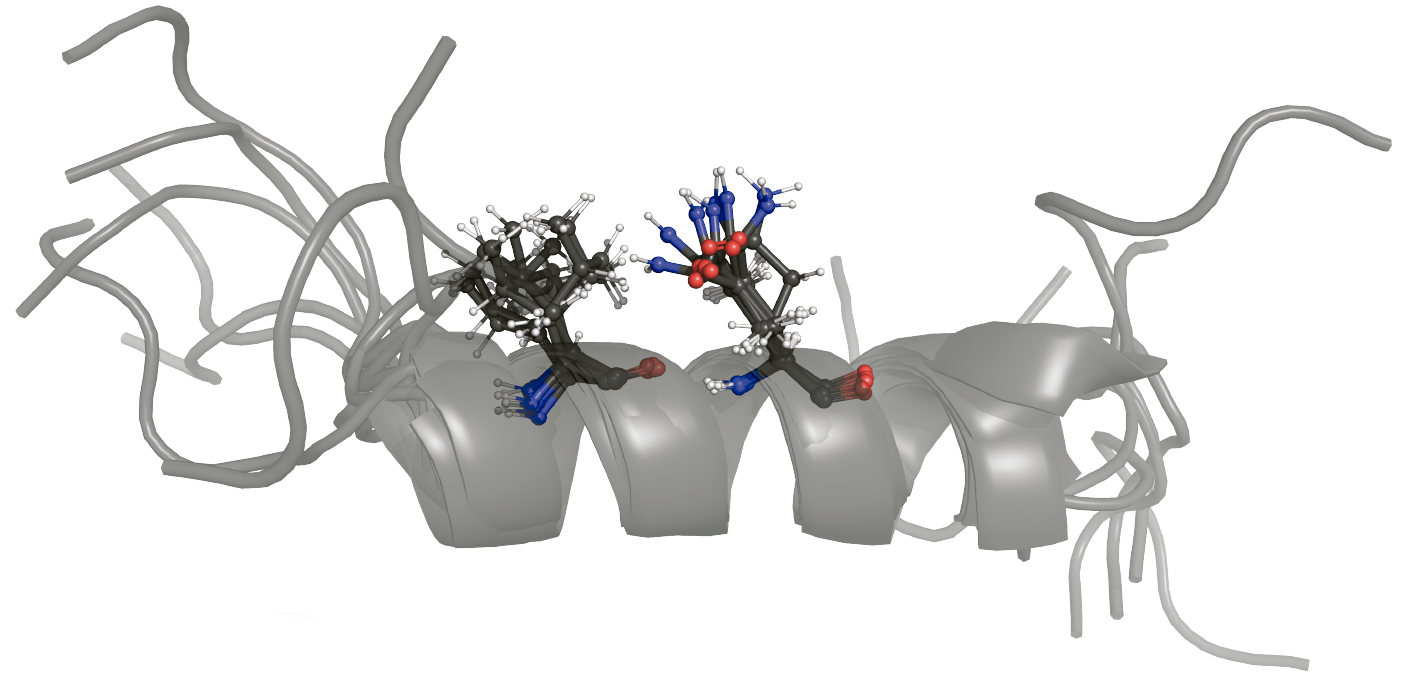Proteins constantly interact with one another inside cells to perform various tasks. Blocking the binding of two or more proteins appears as a potential treatment for some diseases where these functions are altered.
 Alpha helix-shaped structure of one of the peptides designed in this study. Image Credit: Institute for Research in Biomedicine
Alpha helix-shaped structure of one of the peptides designed in this study. Image Credit: Institute for Research in Biomedicine
In the journal Nature Communications, researchers at IRB Barcelona under the direction of Dr Xavier Salvatella, an ICREA researcher, have published guidelines for creating synthetic molecules that prevent the interaction of two proteins.
The interactions between the proteins that are defined by the binding of an α-helix from one protein to the surface of the other have been the researchers’ main focus. This interaction mechanism is widespread and pervasive in cellular processes that are therapeutically relevant to conditions like prostate cancer.
Using the guidelines provided in this work, scientists can create molecules that block (possibly) any interaction between a globular protein and an α-helix, offering high versatility. These artificial molecules are soluble in water, exhibit high stability, and can enter the cell’s interior. These qualities make them excellent candidates for drugs.
Our work proposes a simple way to block interactions between globular proteins mediated by α-helices and it can benefit both protein engineering and drug development efforts. It is an approach based on research performed by our lab addressing the natural interactions of certain proteins, and it proposes using this knowledge to achieve therapeutic objectives through the design of small molecules with artificial sequences.”
Dr Xavier Salvatella, Head, Molecular Biophysics Laboratory, IRB Barcelona
Competition for a binding site
Since a region on their surfaces “fits,” binding can occur when two proteins “recognize” each other in the cell. The molecules discussed in this work, like many commonly prescribed medications, mimic this site on the surface of one of the proteins involved in the interaction, causing them to “compete” for binding to the site of the other protein, also known as the target protein.
As a result, if the rival molecule is present in greater amounts or has a higher affinity for the target protein, it will occupy all the binding sites and prevent any potential interactions with the real protein that the drug is imitating. However, it is challenging to mimic the binding surface between large protein interaction interfaces due to their size.
What we propose in this work is to create molecules in the form of α-helices that offer a configurable surface to “fit” the target protein, and we explain how to ensure that this helix maintains a stable structure in the cellular context.”
Dr Albert Escobedo, Postdoctoral Researcher, Center for Genomic Regulation
Describing the interactions and searching for a stable structure
The focus of the researchers’ work has been on defining the requirements that these artificial molecules must meet to be stable and capable of carrying out their intended function of impeding protein-protein interaction.
According to the study, the helix becomes more stable when repeated numerous times in a row with a particular pattern of pairs that includes the amino acids glutamine and another hydrophobic amino acid.
The new guidelines described can improve the biocompatibility and safety of the drugs created using these guidelines in comparison to other methods with the same goal due to the exclusive use of natural amino acids and the absence of chemical modifications to stabilize the helix.
The researchers had previously noted that, for a given protein, the number of glutamine residues present in the structure conditions the stability of its helix-shaped structure. This observation was made in a different study that was published in Nature Communications in 2019.
In the new study, the authors confirm that other proteins also experience the same phenomenon; they then go on to explain why this is the case and apply their findings to broaden the applicability of the molecules they have created.
They also suggest that different diseases could be brought on by variations in the number of glutamine residues found in various proteins.
Source:
Journal references:
- Escobedo, A., et al. (2022). A glutamine-based single α-helix scaffold to target globular proteins. Nature Communications. doi.org/10.1038/s41467-022-34793-6
- Escobedo, A., et al. (2019). Side chain to main chain hydrogen bonds stabilize a polyglutamine helix in a transcription factor. Nature Communications. doi.org/10.1038/s41467-019-09923-2